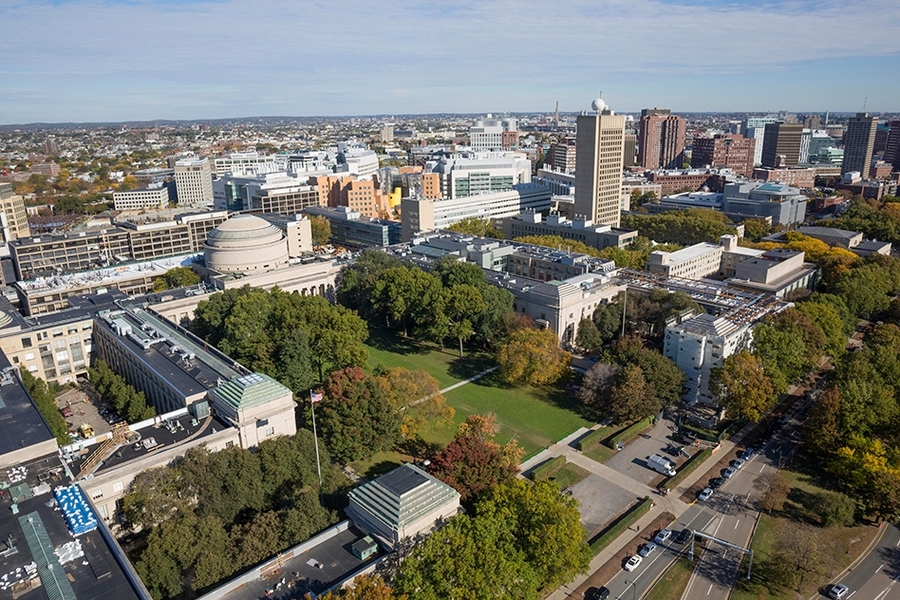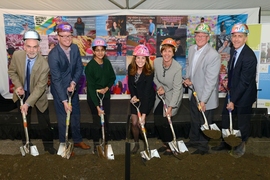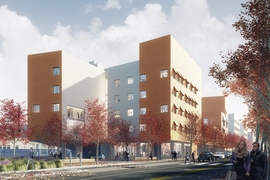At the start of the of 2019-20 academic year, Housing and Residential Services (HRS) began to work with the Eastgate Apartments community to prepare for the building’s closure and residents’ transition to new housing. After the Office of the Vice Chancellor announced a series of new graduate student support measures, HRS released 2020-21 rental rates for the new Graduate Tower at Site 4 and all other graduate student residences on Feb. 5. The Institute established the rates in keeping with recommendations from the 2018 Graduate Student Housing Working Group Report, and announced a number of measures designed to make the transition to new housing more affordable for current Eastgate graduate student residents. In a conversation with the Division of Student Life (DSL), Senior Associate Dean for HRS David Friedrich reiterated MIT’s commitment to ensuring graduate students are financially secure and have access to quality, affordable housing during their time at MIT.
Q: Housing and Residential Services (HRS) is actively working with other campus partners on housing affordability and financial support matters for current and future graduate students. Can you say more about that ongoing effort?
A: MIT is committed to making sure that current and future graduate students can thrive at MIT. Senior leaders know we need to make it financially viable for graduate students to complete their programs. And we know that housing costs make up a big portion of students’ budgets and can also be a source of stress. We are working closely with partners across campus to put holistic financial support measures in place to alleviate that stress.
The Office of the Vice Chancellor, in partnership with the school deans and the provost, is helping graduate students in acute financial distress (in particular those who have children living with them) and those on partial appointments, and is supporting graduate students who are experiencing short-term financial challenges. They have launched new grant programs to assist members of our community who find themselves in these situations.
Ultimately, though, MIT needs a more comprehensive approach to graduate student support — measures that go beyond these grant programs and the cost-of-living adjustments addressed by the annual stipend rate-setting process. This is a complex issue that involves HRS, DSL, the chancellor, the vice chancellor, the provost, and the school deans. We are engaging graduate student leaders and partnering with these different stakeholders right now to develop solutions for current and future graduate students.
Q: The recently announced rates for the new Graduate Tower at Site 4 have sparked concerns about housing affordability and financial support, particularly among current Eastgate residents who will need to move when that building closes in August 2020. Can you talk about the ways you've been supporting Eastgate residents during this transition period?
A: I want to be clear that we value the Eastgate community; we understand that these changes have created some uncertainty and stress, and we want to help.
Since the announcement of the rates, we've taken several steps to respond to the concerns we've heard. We held drop-in sessions at Eastgate and listened to what students were saying about the new rates, and we reassured them that we’re committed to making sure they have affordable housing options for next year and throughout their time at MIT.
Our immediate response for providing relief and support to the Eastgate community consisted of extending the 15 percent discount on Site 4 rates for the entire time that Eastgate graduate students who move to Site 4 are in their current program. We also quickly established a personalized transition subsidy program to meet need in partnership with Student Financial Services (SFS).
The program featured a short, low-barrier application and opportunities to talk in person with SFS financial counselors. The majority of applicants received significant transition subsidies so that moving to Site 4 will be more affordable to residents who found themselves in what we’ve described as an exceptional circumstance — they did not make their current housing choice with the benefit of knowing what Site 4 rates would be, and many want to remain in the same community until they finish their MIT program.
To calculate award levels, SFS worked between two bounds. The lower bound of assistance was the Site 4 rate with a 15 percent discount. The upper bound of assistance, for those with the highest need, was based on the current Eastgate rates for an equivalent room type increased by 5.5 percent. This recognizes Site 4’s condition and location as well as the fact that, had Eastgate remained open, a rental increase would have gone into effect. We also note that, as in prior years, there will be an annual increase in student stipends, which is ultimately decided by the provost and the Deans’ Group after seeking input from a team of students, staff, and faculty led by the Graduate Student Council.
There’s been some misunderstanding about the amount of time Eastgate graduate student residents have been given to make decisions about their housing for next year. They have a full three months, between now and the end of April, to evaluate their different on- and off-campus options, and HRS has let them know we can help every step of the way. No matter when an Eastgate graduate student decides to complete the selection process between now and the end of April, they will be given priority based on available space if they elect to move to Site 4 or to another on-campus residence.
Q: This situation has focused attention on MIT’s graduate student housing system. Can you describe the challenges you are facing, as well as the ongoing work to improve the quality of our housing and graduate students’ residential experience?
A: I think it's important to note that MIT is in a significant time of change and transition in housing, and there's been a lot of conversation about how to best respond to the needs of our graduate students and our overall housing system. The students, faculty, and staff who contributed to the recommendations in the 2018 Graduate Student Housing Working Group Report provided us with a very strong roadmap to navigate this period.
The report highlighted the fact that we have about 38 percent of our graduate students living on campus. This means that they are paying rents that are subsidized by MIT to varying degrees. And it means the majority of our students aren’t fortunate enough to live on-campus and must pay market rates for their housing.
The report recommended developing new approaches to delivering housing so that more can be added efficiently in the future. It also showed that we have a lot of challenges facing our existing on-campus system, stating clearly that “Currently our revenue falls short of what is required for comprehensive stewardship. This leads to lower-quality housing and creates an impediment to adding more housing.” The report called for us to move to a comprehensive stewardship model in order to better serve our students and our housing system. By pursuing a phased transition so that all of our units are below market rates, but in a consistent way based on their relative size and quality, we are responding to this recommendation.
The report also identified operational changes that will help us improve more quickly. With the help of the Graduate Student Housing Implementation Team, we’ve been making headway on those operational changes. Old policies limited where students could live depending on whether they were single or couples. They also limited the amount of time students were able to remain in housing. To address these shortcomings, we’ve increased capacity for couples by launching successful pilots offering more places where couples can live. And we now offer all new graduate student residents two consecutive years of housing in all of our graduate student residences (previously, single students were only offered one year of housing).
And I think we're making progress on one of the biggest recommendations from the report — to expand graduate student housing. MIT has already made 70 Amherst Street a new graduate student housing community and, last December, the Institute announced plans to build a 550-unit graduate residence on Vassar Street that will enable us to accommodate more of our graduate students and families. These two steps, along with the net new beds in Site 4, have enabled us to make good on MIT’s commitment to add a total of 950-beds to our graduate student housing stock.









